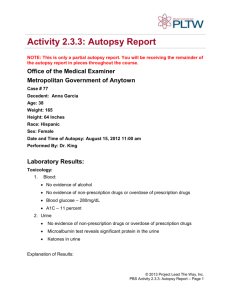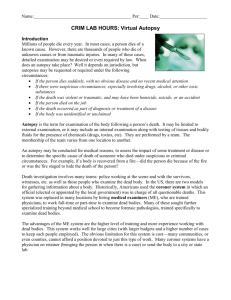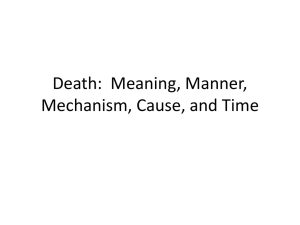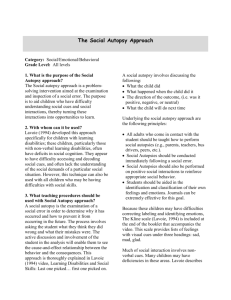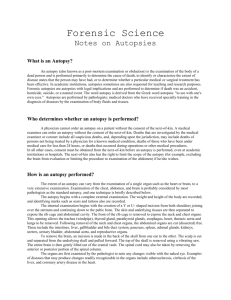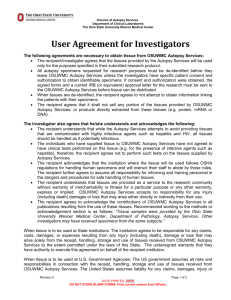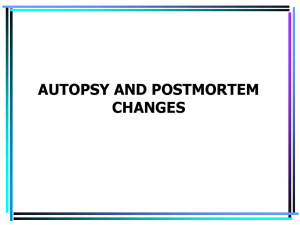Introduction to Autopsy
advertisement
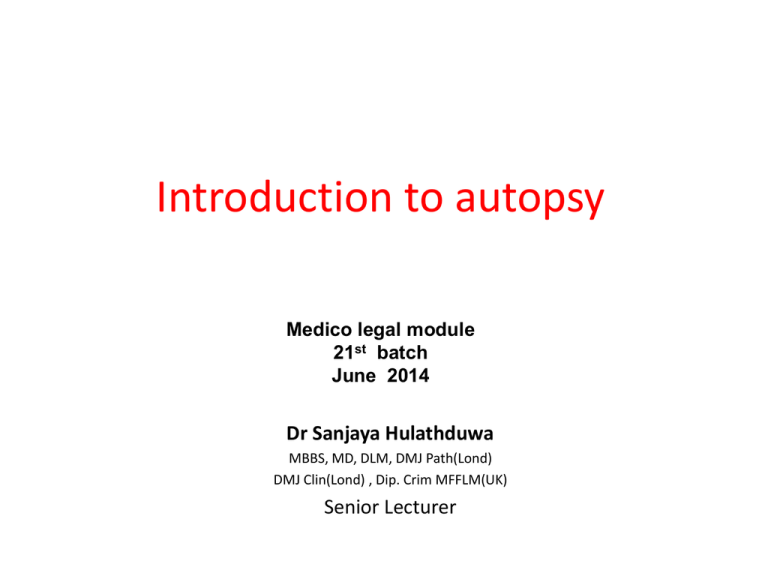
Introduction to autopsy Medico legal module 21st batch June 2014 Dr Sanjaya Hulathduwa MBBS, MD, DLM, DMJ Path(Lond) DMJ Clin(Lond) , Dip. Crim MFFLM(UK) Senior Lecturer • An autopsy is also known as postmortem examination. • This is the final scientific investigation into a person’s death. • There are two major forms/types of an autopsy, viz: a. Judicial/Forensic/Medicolegal autopsy b. Pathological autopsy Objectives of an autopsy • • • • • • • Identification of the deceased Time since the death Place of the death Cause of death Circumstance/manner of death Interpretation of injuries Any other opinions (period of survival, volitional activities, mode of disposal, reconstruction of the event, nature of the weapons involved, use of alcohol and drugs etc.) • Collection of trace evidence/samples Medico legal autopsy • A part of the medico legal investigation into a death • Conducted by a judicial medical officer or any other designated medical officer • Authority is given at an inquest • No consent required from the relations • Post Mortem Report (PMR) is given to the inquirer (ISD/Magistrate) • Cause of death is given after the autopsy • Any body tissue/sample could be retained for further investigations • Mode of disposal of the body is decided by the inquirer Requirements for a Medico legal autopsy 1. Judicial requirements Written order from the ISD or Magistrate 2. Medical requirement A government medical officer or a lecturer from University Forensic Medicine Department. They are considered as experts in the field of diseases and injuries (Section 45 Evidence Ordinance) 3.Physical requirements Equipments Autopsy room with autopsy table, ventilation, illumination and running water Others accessories Trained autopsy labourers /mortuary “cutters” Procedure There are ten steps of an autopsy 1. History 2. Visit to the scene 3. Identification of the deceased 4. Preliminary procedures 5. Examination of clothing 6. General external examination 7. Specific external examination 8. Internal examination 9. Laboratory investigations 10. Documentation and reporting History • From - Relations Eye witnesses Police officer Suspect/Accused Any other person Past medical records Visit to the scene • If the body is still at the scene • After the autopsy (retrospective scene visit) Objectives of the scene visit-read lecture on Scene of Crime Identification of the deceased • Close relations • Friends • Associates/work mates etc. Usually by facial identification, in the presence of the JMO, in good light, while the body is on the autopsy table. If not how? Preliminary procedures • Photography Features for identification Patterned injuries- Bite marks, tyre marks Injury patterns- Child abuse, torture, bomb Violence • Radiology Fire arms, explosives, child abuse, burnt bodies, torture, putrefied bodies, unidentified bodies • Collection of trace materials Sexual offences, fire arms, abortions, deaths due to explosions, burns Examination of clothing • Depends on the type of the death. • Unidentified bodies • Sexual offences • Fire arms • Road traffic accidents • Burnt bodies • Explosion deaths • Drowning…..etc. etc. • Clothes for identification • Injuries found on clothes cuts, tears, penetrations • Trace materials blood, paint, vomitus, semen, oil, glass particles, firearm residues, stains….. • Any other Suicide note General external examination • Height, weight, built, nourishment, hair, eyes, complexion, post-mortem changes…. • Scars, marks, tattoos and other identifying features • Evidence of natural diseases • Natural openings • And many more………………………… Specific external examination • Depend on the type of autopsy and its objectives: • Unidentified bodies • Time since death • Body moved after death • Sexual offences • Injuries Internal examination • Opening up of all body cavities • Evisceration of all organs • Dissection of all organs • Head • Neck • Chest, abdomen • Pelvis • (may need to dissect other parts such as spinal code and skeletal muscles) Dissection techniques • • • • • • • Standard Dissection- “chin to pubis” Special Neck Dissection Facial dissection (as an extension of neck dissection) Musculo-skeletal Dissection Spinal Dissection Pelvic Dissection Other (Eye, Middle ear, Neuropathological) laboratory investigations • Depends on the autopsy Toxicological Dept. of Govt. Analyst Blood, urine, bile, stomach contents, Liver, kidney, brain, vitreous humor Histopathological Any affected organ or injury sites Other microbiological, Diatom studies, haematological/serological, enzyme studies, genetic studies, ballistic, entomological etc. Samples for laboratory investigations contd. • Histopathology • In 10% Formol saline • Toxicological samples – no presevatives Documentation and reporting • Findings • Opinion (eg. Cause of Death ) • Other remarks Compiled in the PMR-Post Mortem Report (H 42 form) Whom to send and how to retain? Question: What is an obscure autopsy and how does it differ from a true negative autopsy? PATHOLOGICAL AUTOPSY • Clinical autopsy (also termed Hospital autopsy in the UK and Australia) • Done to gather information about: a disease/disease process Pathology unidentified during life Effectiveness of treatment Pathological autopsy-requirements and procedure • • • • • • • • • Cause of death must be known and must be natural Declaration of death must be filled before the autopsy No suspicions/allegations about the circumstance No inquest to the death Written consent from the next of kin Full or partial dissection could be employed Only relevant body cavities opened Special consent obtained to retain samples Done by the hospital histo-pathologist in the presence of clinical staff of the ward • Approval from the head of the institution • Usually not carried out in high risk cases (HIV, Hep. B, other highly infectious/hazardous conditions) • Do not delay (unethical) • PM findings, samples taken must be documented on the BHT • Findings must be kept confidential


